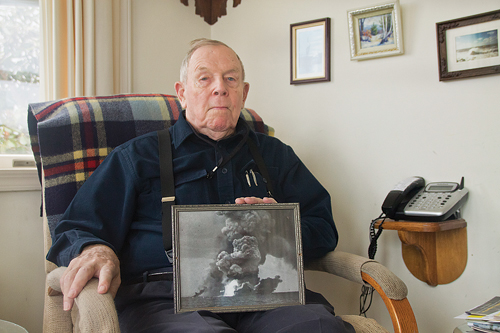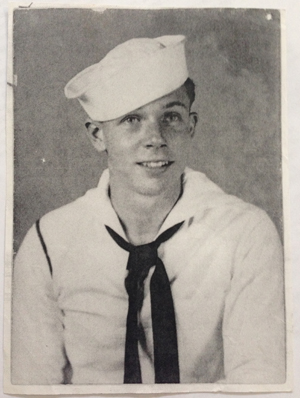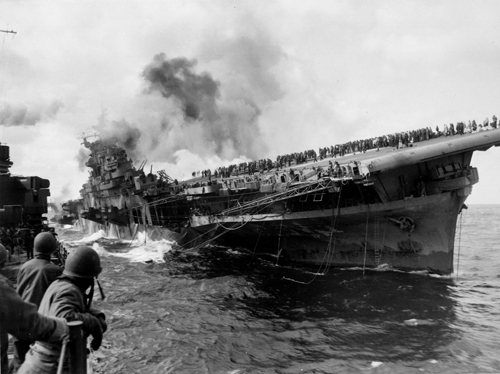Column: A vet’s battle for his life and his legacy

Southold resident Bob Mallgraf owes his life to a long breakfast line.
It had been a long night manning the radar aboard the USS Franklin in World War II about 50 miles off the coast of Japan, while enemy planes and ships snooped around for their location. He was ready to eat.
So when Captain Leslie Gehres told the crew to get breakfast the morning of March 19, 1945, leaving the ship exposed, Mr. Mallgraf headed to mess hall.
“I went down there and the line was a mile long,” he recalls decades later. “I figured, ‘Jeez, I’ll never get any breakfast.’ “
He gave up and went back to his battle station. Just then, two Japanese bombs burst through the flight deck. Every sailor waiting in line was killed, he said.
Mr. Mallgraf was stranded on board and watched from the bridge as sailors dove into the water to avoid the explosions and Captain Gehres ran around helplessly as flames rose from the deck.
The story of Mr. Mallgraf — who would go on to become a longtime Southold firefighter — is one of hundreds from that day, a day when many sailors tried to survive by abandoning the badly damaged ship only to be derided as deserters years later by the ship’s captain, whom Mr. Mallgraf says was too proud to admit his own mistakes.
A small room in Mr. Mallgraf’s basement is, in part, a tribute to the ship and her crew. Photos of the USS Franklin adorn the walls, with newspaper clippings arranged above a desk framed by a large poster advertising a film about the ship.
He sits at the desk 69 years later, staring toward the door as if expecting some old memory to walk through.
Then he remembers.

In 1943 — two years before the USS Franklin became the most heavily damaged ship to survive World War II and five days before his 18th birthday — Mr. Mallgraf walked into a recruiter’s office in New York City and joined the U.S. Navy.
“I would have been drafted but I wanted to be in the Navy,” he says. “I wanted to get a clean bed and a few hot meals a day.”
Mr. Mallgraf was sent to radio training and, months later, met his ship: an 872-foot-long, 27,100 ton Essex-class aircraft carrier named Franklin.
“That was the biggest thing I’d ever seen,” he remembers. “It looked like the Empire State Building laying on its side, I swear.”
Mr. Mallgraf took up a cot in the cramped ship and began his tour.
On Oct. 13, 1944, he and the rest of the USS Franklin crew were among the first to witness what would soon become a grave signature of the Pacific Theater: a kamikaze attack.
The plane, part of a group of aircraft attacking the ship, slammed into the vessel near its tower before sliding off the deck and into the ocean. A later attack sent the aircraft carrier back to the United States for repairs.
By 1945, the USS Franklin was again out on the water and in service with a new — and generally derided — commander: Captain Gehres.
It was the captain’s decision to leave the ship “wide open” so close to the Japanese mainland that caused the disaster on March 19, Mr. Mallgraf believes. The lone Japanese bomber caught the Franklin unprepared.
Fires caused by the bombs trapped hundreds inside the ship and set the flight deck on fire.

“I was one of the lucky ones,” he says. “I didn’t get scratched … You can’t imagine the fires.”
Mr. Mallgraf and a friend managed to get onto the ship’s bridge, though they were hemmed in by the flames. Mr. Mallgraf remembers seeing his captain barking out orders and “running around like a headless chicken.”
After several hours and with the assistance of nearby U.S. ships, the Franklin’s fires were put out. But by then, more than 800 sailors had died and the USS Franklin was crippled.
Mr. Mallgraf says he was ordered to abandon ship to the cruiser USS Santa Fe, which had come to load up survivors. He crawled across a fallen antenna onto the Santa Fe. But in the months after the disaster, Captain Gehres labeled him and others who left as deserters and had them shuttled to far-off posts as punishment.
The captain bragged to stateside papers about his “loyal crew” who remained behind.
It wasn’t until a later military proceeding that all charges against the Franklin’s crew were quietly dropped. But by then, the damage had been done. The crew was shamed, Mr. Mallgraf says.
A few years ago, Mr. Mallgraf helped filmmaker Joseph Springer with a documentary called “Honor Restored,” which chronicled the story of those on board. It was the least he could do, he says.
“Not one guy that left the ship got a decoration or a medal or anything,” he says.
Paul Squire is a staff writer with The Suffolk Times. He can be reached at [email protected] or 631-354-8018.








